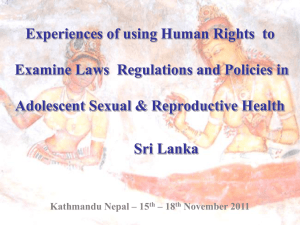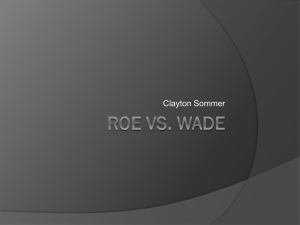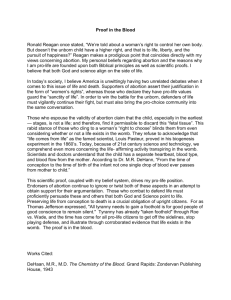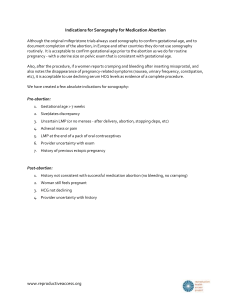here - Notches
advertisement
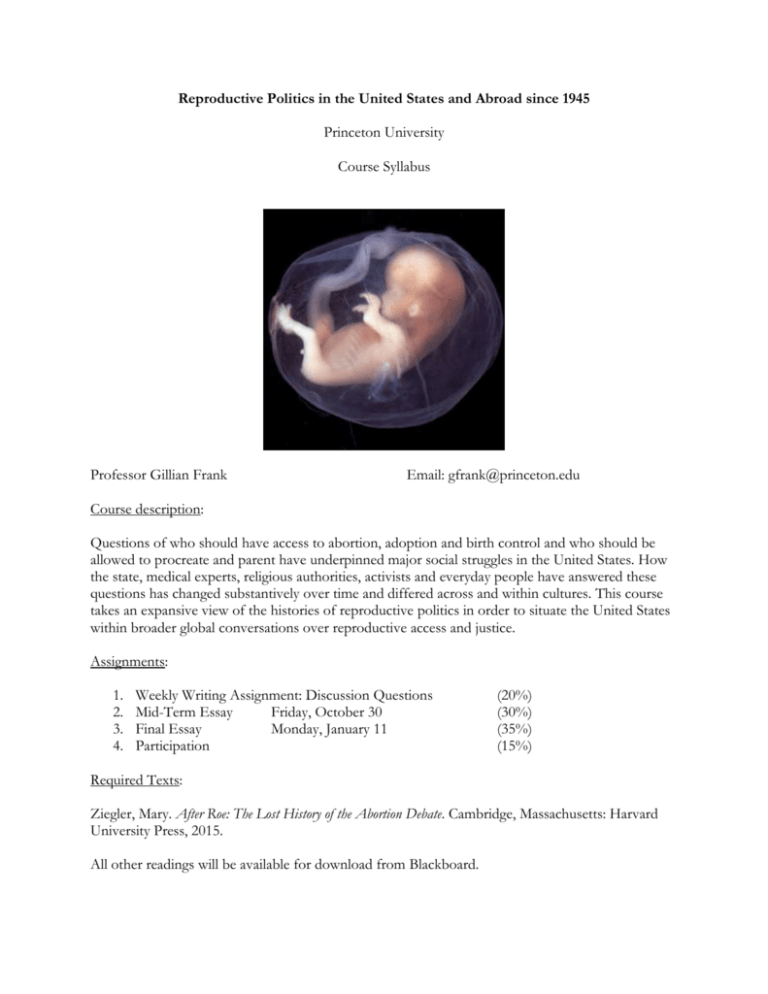
Reproductive Politics in the United States and Abroad since 1945 Princeton University Course Syllabus Professor Gillian Frank Email: gfrank@princeton.edu Course description: Questions of who should have access to abortion, adoption and birth control and who should be allowed to procreate and parent have underpinned major social struggles in the United States. How the state, medical experts, religious authorities, activists and everyday people have answered these questions has changed substantively over time and differed across and within cultures. This course takes an expansive view of the histories of reproductive politics in order to situate the United States within broader global conversations over reproductive access and justice. Assignments: 1. 2. 3. 4. Weekly Writing Assignment: Discussion Questions Mid-Term Essay Friday, October 30 Final Essay Monday, January 11 Participation (20%) (30%) (35%) (15%) Required Texts: Ziegler, Mary. After Roe: The Lost History of the Abortion Debate. Cambridge, Massachusetts: Harvard University Press, 2015. All other readings will be available for download from Blackboard. Schedule of Classes, Readings, and Assignments: September 21. Week 1: Reproductive Politics at Home and Abroad Carole Vance, “Social Construction Theory: Problems in the History of Sexuality” in Knowing Women: Feminism and Knowledge. Eds. Helen Crowley and Susan Himmelweit. (Cambridge: Polity Press, 1992): 132-146. Leslie Reagan, “Raids and Rules,” When Abortion Was a Crime: Women, Medicine, and Law in the United States, 1867-1973. Chapel Hill: University of North Carolina Press, 1998. 160-193. Elaine Tyler May, “Introduction,” “The Baby Craze: The Rise of Compulsory Parenthood,” Barren in the Promised Land: Childless Americans and the Pursuit of Happiness. Cambridge: Harvard University Press, 1997. Primary Sources: “Letter to the Society for Humane Abortion,” “‘Rush Procedure for Going to Japan” Before Roe v. Wade: Voices That Shaped the Abortion Debate Before the Supreme Court’s Ruling. 2 edition. New Haven, CT: Yale Law Library, 2012. 7-11. September 28. Week 2: The Politics of Fertility and Motherhood in the 1950s Ann Fessler, “Good Girls v. Bad Girls,” “Going Away,” The Girls Who Went Away: The Hidden History of Women Who Surrendered Children for Adoption in the Decades Before Roe v. Wade. New York: Penguin Books, 2007. 29-54, 133-164. Regina Kunzel, “Pulp Fictions and Problem Girls: Reading and Rewriting Single Pregnancy in the Postwar United States.” The American Historical Review 100, no. 5 (December 1, 1995): 1465–1487. Lori Chambers, “Adoption, Unwed Mothers and the Powers of the Children’s Aid Society in Ontario, 1921-1969,” Ontario History 98.2 (Autumn 2006): 161-182. Primary Source: Katharine Kinkead, “The Lonely Time,” The New Yorker, January 20, 1951. October 5. Week 3: The Race for Reproduction Rickie Solinger, “Race and ‘Value’: Black and White Illegitimate Babies, 1945-1965,” Unequal Sisters: A Multicultural Reader in U.S. Women’s History (New York: Routledge, 1994): 463-479. Elena R. Gutiérrez, “Policing 'Pregnant Pilgrims': Welfare, Health Care and the Control of Mexicanorigin Women’s Fertility” in Women, Health and Nation: The U.S. and Canada since 1945. (Toronto: McGill-Queens University Press, 2003): 379-403. Rebecca Kluchin, “Sterilizing Unfit Women,” Fit To Be Tied: Sterilization And Reproductive Rights In America, 1950-1980. New Brunswick, N.J.: Rutgers University Press, 2011. 73-113. Aiko Takeuchi-Demirci, “The Color of Democracy: A Japanese Public Health Official’s Reconnaissance Trip to the US South” (2011). http://www.southernspaces.org/2011/colordemocracy-japanese-public-health-officials-reconnaissance-trip-us-south. Primary Source (film): “How Much Affection” (1958) October 12. Week 4: Reproductive Politics and Sexual Knowledge Before and After Griswold Rickie Solinger, “‘A Complete Disaster’: Abortion and the Politics of Hospital Abortion Committees, 1950-1970” Feminist Studies Vol. 19, No. 2 (Summer 1993): 240-268. Mary L. Dudziak, “Just Say No: Birth Control in the Connecticut Supreme Court before Griswold v. Connecticut.” Iowa Law Review 75 (1989): 915-939. Carole Joffe, “Portraits of Three ‘Physicians of Conscience’: Abortion Before Legalization in the United States.” Journal of the History of Sexuality 2, no. 1 (July 1, 1991): 46–67. Wendy Kline, “Transforming Knowledge: The Making of Our Bodies Ourselves,” Bodies of Knowledge: Sexuality, Reproduction, and Women’s Health in the Second Wave. University of Chicago Press, 2010. 9-40. Primary Source: Griswold v. Connecticut; Boston Women’s Health Collective, “Women and Their Bodies,” 1970. October 19. Week 5: Reproductive Politics and Religion Before Roe Leslie J. Reagan, “Crossing the Border For Abortions: California Activists, Mexican Clinics, and the Creation of a Feminist Health Agency In The 1960s.” Feminist Studies 26, no. 2 (2000): 323–348. Leslie Woodcock Tentler, “It Isn’t Easy to Be a Catholic”: Rhythm, Education for Marriage, Lay Voices, 1941-1962.” Catholics and Contraception: An American History. Ithaca: Cornell University Press, 2004. 173-203. David Cline, Creating Choice: A Community Responds to the Need for Abortion and Birth Control, 1961-1973, New York: Palgrave, 1993. 19-37, 113-135, 151-171. Primary Sources: Before Roe v. Wade: Voices That Shaped the Abortion Debate Before the Supreme Court’s Ruling. 2 edition. New Haven, CT: Yale Law Library, 2012. 69-81. October 26. Week 6: The Sexual and Racial Politics of Adoption and Custody Ellen Herman, “Adoption Revolutions,” “The Difference Difference Makes,” Kinship by Design : A History of Adoption in the Modern United States. Chicago: University of Chicago Press, 2008. 195-252. Jodi Kim, “An ‘Orphan’ with Two Mothers: Transnational and Transracial Adoption, the Cold War, and Contemporary Asian American Cultural Politics.” American Quarterly 61, no. 4 (2009): 855–880. Daniel Rivers, “‘In the Best Interests of the Child’: Lesbian and Gay Parenting Custody Cases, 1967–1985.” Journal of Social History 43, no. 4 (2010): 917–43. Primary Source: Ellen Agger, “Lesbian Mothers and Custody Rights,” The Body Politic October, 1979, 26-27. November 2. Week 7: No Class. Fall Break. November 9. Week 8: Technologies of the Reproductive Rights Revolution Elaine Tyler May, “Bedfellows, “The Sexual Revolution,” America and the Pill: A History of Promise, Peril, and Liberation. New York: Basic Books, 2011. 35-92. Laura Briggs, “Demon Mothers in the Social Laboratory: Development, Overpopulation and ‘the Pill,’ 1940-1960,” Reproducing Empire: Race, Sex, Science, and U.S. Imperialism in Puerto Rico. Berkeley: University of California Press, 2002. 109-141. Leslie J. Reagan, “Specter of Tragedy,” Dangerous Pregnancies: Mothers, Disabilities, and Abortion in Modern America. Berkeley: University of California Press, 2012. 55-104. Primary Sources: Sherri Chessen Finkbine, “The Lesser of Two Evils,” Before Roe v. Wade: Voices That Shaped the Abortion Debate Before the Supreme Court’s Ruling. 2 edition. New Haven, CT: Yale Law Library, 2012. 11-18. Optional: Sarah Abigail Leavitt, “‘A Private Little Revolution’: The Home Pregnancy Test in American Culture.” Bulletin of the History of Medicine 80, no. 2 (2006): 317–345. November 16. Week 9. Activists and the Reproductive Rights Revolution Shannon Stettner, “The State Does not Belong in the Uterus of the Nation” Rebecca Kluchin, “‘Fit’ Women Fight Back,” “Unfit Women Fight Too,” Fit To Be Tied: Sterilization and Reproductive Rights In America, 1950-1980. New Brunswick, N.J.: Rutgers University Press, 2011. 114-183. Jennifer Nelson, “‘All This That Has Happened to Me Shouldn’t Happen to Nobody Else’: Loretta Ross and the Women of Color Reproductive Freedom Movement of the 1980s.” Journal of Women’s History 22, no. 3 (2010): 136–160. “Leona’s Sister Gerri,” Directed by Jane Gilooly. Independent Television Service, 1994. Primary Sources: Before Roe v. Wade: Voices That Shaped the Abortion Debate Before the Supreme Court’s Ruling. 2 edition. New Haven, CT: Yale Law Library, 2012. 36-52. November 23: Week 10. The Politicization of Abortion Daniel Williams, “The GOP’s Abortion Strategy: Why Pro-Choice Republicans Became Pro-Life in the 1970s,” Journal of Policy History 23 (2011): 513-539. Gillian Frank, “The Color of the Unborn: Anti-Abortion and Anti-Busing Politics in Michigan, 1967-1973,” Gender and History, 26, no. 2 (August 2014): 351-378. Primary Sources: Before Roe v. Wade: Voices That Shaped the Abortion Debate Before the Supreme Court’s Ruling. 2 edition. New Haven, CT: Yale Law Library, 2012. 81-115, 157-160, 210-220. November 30: Week 11. Reproductive Politics After Legalization (I) Mary Ziegler, After Roe: The Lost History of the Abortion Debate. Cambridge, Massachusetts: Harvard University Press, 2015. Chapters 1 -3. Christabelle Sethna, “All Aboard? Canadian Women's Abortion Tourism, 1960-1980,” Gender, Health, and Popular Culture: Historical Perspectives. Waterloo: Wilfrid Laurier University Press, 2011. December 7: Week 12. Reproductive Politics After Legalization (II) Mary Ziegler, After Roe: The Lost History of the Abortion Debate. Cambridge, Massachusetts: Harvard University Press, 2015. Chapters 4-6. Stephen Brooke, “Second Wave Feminism, Labour, and the Defence of the Abortion Act, 19671990,” Sexual Politics: Sexuality, Family Planning, and the British Left from the 1880s to the Present Day. Oxford: Oxford University Press, 2011. Primary Source: “The Silent Scream” (1984) December 14: Week 13. Our Bodies. Our Selves. Our Present. Review.

